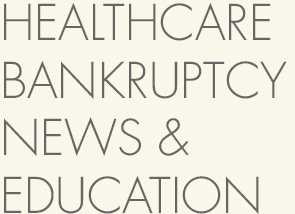Hundreds of thousands of Americans file for personal bankruptcy each year. You might think, as I did, that most of them are a case of job loss or bad spending habits. I’m sure that these are reasons. However, the overwhelming reason for personal bankruptcy is medical bills.
Just how big is the problem? The American Journal of Medicine a few years ago reported that more than 3 out of 5 personal bankruptcies are due to medical bills. To put the problem in perspective, just look at the numbers from 24 years ago. In 1981, medical bills were a factor in bankruptcy as well, but just eight percent. Eight percent then to over 60 percent today!
The bottom line is that bankruptcies, also known by the term BK, are no longer insignificant and should be looked at seriously as a source of revenue. As more and more facilities realize the potential, there are several myths that should be dispelled. These myths could not only be costing facilities a loss of revenue, it can also be a source of liability.
Patient Bankruptcy Myth #1 .. Writing off BK’s Reduces Liability
This is by far the biggest misconception. All patient bankruptcies require strict compliance on behalf of the hospital. By failing to comply, which means stopping collection efforts, the facility is in violation of a court order. An attempt to collect money from a patient who has declared bankruptcy could bring attorney fees and even punitive damages, costing thousands. Not filing a claim has nothing to do with compliance. It’s about recognizing when a patient goes bankrupt and immediately stopping all collection efforts.
To show how prevalent this problem is, let’s take a simple example that happens on a regular basis across the country. Once a patient fails to pay over a set period of time, often 90-120 days, facilities outsource the account for first and/or third party collections. These agencies then go about the process of collecting on as many accounts as possible through contacting patients. The problem arises when agencies aren’t aware of which patients have filed for bankruptcy and attempt to contact them.
The large majority of agencies are not proficient at identifying patient bankruptcies due to the intricacies of the process, legal and otherwise. A small percentage of agencies will scrub accounts for bankruptcy filings, but usually on a monthly or quarterly basis. Once identified, the accounts of bankrupt patients are returned to the facility. By this time, the filing deadline has often passed and the facilities will not receive any money. This leads directly to our next myth.
Patient Bankruptcy Myth #2 .. Bankruptcies are Not Worth the Time & Money
If you ask healthcare professionals they would probably say that collecting on patient bankruptcies isn’t worth much, maybe a few percent at best. The truth is that they can bring in up to 25%!
Not all personal bankruptcies are equal however. Most filings for bankruptcy will be either Chapter 7 or Chapter 13. Chapter 11 filings are allowed by individuals but it is usually rare. Between Chapters 7 & 13, there is a big difference. To get right to the point, it’s the Chapter 13’s that can be worth up to 25%.
When a patient goes into bankruptcy, a list of creditors is compiled. Based on simple math, if there are 10 creditors they all will receive 10% of the money allotted. However, in most cases a certain number of creditors will not file. That means the remaining ones will collect a higher percentage.
Patient Bankruptcy Myth #3 .. Filing a Proof of Claim Harms Patients
There is no doubt that filing for personal bankruptcy is a very hard and humbling experience. However, the money that is distributed to creditors goes through a strict government mandated bankruptcy process. Healthcare facilities are like any other creditor when it comes to claiming bankruptcy dollars. The money will be distributed, the question is just to which creditors. Referring back to the previous myth, the amount of money distributed to an individual creditor depends on how many other creditors filed claims. So filing a claim does not hurt a patient and cause more financial hardship.
It’s important to know that during the bankruptcy process, healthcare facility never contact patients. In fact, it’s illegal to contact a patient who has filed for bankruptcy, as explained in Myth #1. If a hospital chooses to hire an outside company to file claims on their behalf, that company also cannot contact patients. The entire process, all paperwork and collection of bankruptcy dollars, is done through a federally mandated process with strict oversight.
The Solution is a Proactive Strategy
- Identify all Patient Bankruptcies Immediately
- Stop All Collection Efforts on Bankrupt Patients
- File Proofs of Claim in a Timely Manner
- Follow up on Changes in Status
- Monitor Accounts as Full Payouts Could Take up to 10 Years
For most healthcare facilities, it’s worth a fresh look at patient bankruptcies and how they are being handled. At minimum, bankruptcies should be immediately identified and third party collections should stop to prevent liability. Once that procedure is in place, facilities can explore various ways to collect money that could be a significant source of revenue over time.
Leave a Reply
You must be logged in to post a comment.



